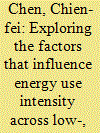|
|
|
Sort Order |
|
|
|
Items / Page
|
|
|
|
|
|
|
| Srl | Item |
| 1 |
ID:
149851


|
|
|
|
|
| Summary/Abstract |
This paper addresses possible effects of the growing focus on global warming on households’ domestication of energy and the dynamics of energy consumption by comparing data pertaining to the domestication of energy within Norwegian households from two time periods: first, 1991–1995, when climate change was given little public attention, and, second, 2006–2009, after climate change became a major public concern. In the first period, we observed that the domestication of energy resulted in an energy culture emphasizing comfort and convenience with respect to everyday life and the abundant supply of clean hydropower. In the second period, this culture seemed to have changed, making households more concerned about their energy consumption. Consumption of energy was linked to climate change, and many interviewees claimed to save energy. However, the dominant expectation was still to be able to manage everyday life in a convenient and comfortable way. Thus, climate change concerns produced some but not very radical changes in the practical domestication of energy, including energy saving. A main effect was feelings of guilt, tempered by arguments regarding why change is difficult and complaints about political inaction. Thus, public engagement with climate change issues may facilitate energy efficiency policy but to succeed, wider climate policy measures seem to be needed.
|
|
|
|
|
|
|
|
|
|
|
|
|
|
|
|
| 2 |
ID:
176785


|
|
|
|
|
| Summary/Abstract |
Whether there will be a long-run equilibrium (steady state) in energy demand per capita is a critical question for energy and environmental policy makers. While many studies have been done on energy production and energy consumption, little attention has been paid to whether disparities in relative household energy consumption (RHEC) converge, and how the use of aggregated data has serious limitations. This paper is the first study to investigate the convergence and dynamics of household energy consumption in China. The results are helpful to Chinese policy makers when trying to identify the key groups for priority interventions. The study finds that variability in the RHEC is very high and that many households will likely change their energy consumption patterns in the coming years. Overall, Chinese households have two convergence clubs. The current dynamics will probably lead to lower energy consumption for most households. The study suggests that policy makers should pay particular attention to households that have too low or too high RHEC level, mainly in rural areas and in the western region.
|
|
|
|
|
|
|
|
|
|
|
|
|
|
|
|
| 3 |
ID:
098610


|
|
|
|
|
| Publication |
2010.
|
| Summary/Abstract |
Improving access to affordable modern energy is critical to improving living standards in the developing world. Rural households in India, in particular, are almost entirely reliant on traditional biomass for their basic cooking energy needs. This has adverse effects on their health and productivity, and also causes environmental degradation. This study presents a new generic modelling approach, with a focus on cooking fuel choices, and explores response strategies for energy poverty eradication in India. The modelling approach analyzes the determinants of fuel consumption choices for heterogeneous household groups, incorporating the effect of income distributions and traditionally more intangible factors such as preferences and private discount rates. The methodology is used to develop alternate future scenarios that explore how different policy mechanisms such as fuel subsidies and micro-financing can enhance the diffusion of modern, more efficient, energy sources in India.
|
|
|
|
|
|
|
|
|
|
|
|
|
|
|
|
| 4 |
ID:
118849


|
|
|
|
|
| Publication |
2013.
|
| Summary/Abstract |
Germany aims to reduce CO2 emissions by 80% by 2050 compared to 1990 levels and has merged this target with mandatory Energy Saving Regulations for thermal renovation of existing homes: the policy uses the criterion of 'economic viability', whereby renovations must pay back through the space and water heating fuel savings they produce. This paper explores the extent to which economically viable thermal renovations can contribute to the 80% goal, based on an analysis of Germany's experience. It finds that the theoretical savings being achieved, based on calculated pre- and post-renovation consumption, are around 33%, while actual savings, based on measured consumption, are likely to be around 25%. The difference appears to be due to the effects of household behaviour. Further, average measured consumption is estimated to be around 150-180 kWh/m2a nationally, and this would have to be reduced to 30-35 kWh/m2a to meet the 80% policy goal. This is beyond the limits of economically viable renovation technology, which currently achieves around 100 kWh/m2a. The paper suggests that policymakers should de-couple the criterion of economic viability from the 80% goal, emphasise other reasons for renovating to economically viable levels, and consider a more systematic approach to facilitate household behaviour change.
|
|
|
|
|
|
|
|
|
|
|
|
|
|
|
|
| 5 |
ID:
170348


|
|
|
|
|
| Summary/Abstract |
We estimate China urban household energy demand as part of a complete system of consumption demand so that it can be used in economy-wide models. This allows us to derive cross-price elasticities unlike studies which focus on one type of energy. We implement a two-stage approach and explicitly account for electricity, domestic fuels and transportation demand in the first stage and gasoline, coal, LPG and gas demand in the second stage. We find income inelastic demand for electricity and home energy, but the elasticity is higher than estimates in the rich countries. Demand for total transportation is income elastic. The price elasticity for electricity is estimated to be −0.5 and in the range of other estimates for China, and similar to long-run elasticities estimated for the U.S.
|
|
|
|
|
|
|
|
|
|
|
|
|
|
|
|
| 6 |
ID:
186437


|
|
|
|
|
| Summary/Abstract |
This study examines the relationships between energy use intensity (EUI), which is considered to be an indicator of energy efficiency, and dwelling or housing characteristics, technology (appliances), socio-demographic characteristics, geographic factors, and energy-related behavioral actions. Additionally, it explores whether these relationships vary across low-, medium-, and high-income households. The study is based on regression analyses conducted on a representative sample of households, the 2015 U.S. Residential Energy Consumption Survey. Overall, the analysis revealed two important findings. First, residential energy use intensity is shaped significantly by housing characteristics, socio-demographic factors, technology, and energy-related behavioral actions. Second, the relationships between the factors examined and energy use intensity vary quite substantially across income groups. Lower income households have a higher EUI than higher income households. The policy implications of these findings are that reducing EUI in the residential sector, which may help with addressing energy burdens and poverty among low-income households, will require paying careful attention to these factors and their dynamic impacts across income groups.
|
|
|
|
|
|
|
|
|
|
|
|
|
|
|
|
| 7 |
ID:
171393


|
|
|
|
|
| Summary/Abstract |
Evidence from south-central Chile shows that the concentration limits for PM10 and PM2.5, defined by both the World Health Organization and national standards, are systematically exceeded, affecting approximately 10 million people. Among the sources of this pollution, firewood use accounts for the largest share. This study assesses whether consumers value environmental, social, and legal attributes associated with the firewood certification programs. We used a discrete choice model based on a sample of 500 households. According to our results, the price premium for certified firewood is about 10% in the most likely scenario, with those attributes closely related to private benefits having a higher value, compared to those of social benefits. We identify significant heterogeneity among respondents belonging to two different consumer classes: 1) those who are less price sensitive and are willing to pay for attributes related to certification; 2) those who are sensitive to prices and are not willing to pay for attributes related to certification. Since the second class includes about 46% of the sample, the implementation of certification programs could be jeopardized. Therefore, knowing this information helps us determine whether a certification system can foster the firewood industry transition to a more sustainable model.
|
|
|
|
|
|
|
|
|
|
|
|
|
|
|
|
| 8 |
ID:
094854


|
|
|
|
|
| Publication |
2010.
|
| Summary/Abstract |
Information and communication technologies (ICTs) increasingly permeate everyday life in industrialized societies. The aim of this paper is to explore ICT-related transformations of everyday practices and discuss the implications, particularly for residential electricity consumption. The present socio-technical changes are seen in a historical perspective, and it is argued that the integration of ICT into everyday practices can be seen as a new round of household electrification, comparable to earlier rounds that also led to higher electricity consumption. A case study carried out in Denmark in 2007-2008 explores the present changes in everyday life. Based on qualitative interviews, the study focuses on people's ways of integrating ICTs into their everyday practices, on any significant changes in these practices, and on the influence of the changed practices on electricity consumption. The paper concludes with a discussion on the implications for energy policy.
|
|
|
|
|
|
|
|
|
|
|
|
|
|
|
|
| 9 |
ID:
117230


|
|
|
|
|
| Publication |
2013.
|
| Summary/Abstract |
This paper reports on how, over a 12-month period, UK householders interacted with feedback on their domestic electricity consumption in a field trial of real time displays or smart energy monitors. Drawing on the findings of 11 follow-up qualitative interviews with householders involved in a 'Visible Energy Trial', the paper suggests that: (i) over time, smart energy monitors gradually become 'backgrounded' within normal household routines and practices; (ii) the monitors do increase householders' knowledge of and confidence about the amount of electricity they consume; (iii) but, beyond a certain level and for a wide variety of reasons, the monitors do not necessarily encourage or motivate householders to reduce their levels of consumption; and (iv) once equipped with new knowledge and expertise about their levels of electricity consumption, household practices may become harder to change as householders realise the limits to their energy saving potential and become frustrated by the absence of wider policy and market support. The paper concludes by reflecting on the policy and research implications of these findings in relation to future transition pathways to a low-carbon economy.
|
|
|
|
|
|
|
|
|
|
|
|
|
|
|
|
| 10 |
ID:
194449


|
|
|
|
|
| Summary/Abstract |
Understanding of how rural livelihood systems embedded in different social-ecological contexts affect household energy consumption behaviour is critical for facilitating rural energy transition. This study assesses the energy consumption level and structure for three different livelihood systems, including mobile livelihood (ML), semi-settled livelihood (SSL) and settled livelihood (SL), from the pastoral regions of the Tibetan Plateau. Results show that the average household energy consumption in ML, SSL and SL systems is 9250.1, 14 714.3 and 7004.5 kgce, respectively. Although yak dung is the dominant energy source in the ML and SSL systems, commercial energy sources are extensively used. When rural herders are resettled into peri-urban areas, commercial energy sources become dominant though the percentage of yak dung consumption remains high. Mobile livestock production strategies and the associated rangeland tenure regimes and cultural practices are key determinant household energy choice factors of the ML and SSL systems. Comparatively, the role of income is more impactful on fuel consumption patterns in the SL system. Accordingly, this study argues that utilising a livelihood system approach in understanding household energy consumption behaviour allows us to design energy policies and innovative and customised clean energy sources that better fit rural livelihood systems.
|
|
|
|
|
|
|
|
|
|
|
|
|
|
|
|
| 11 |
ID:
166379


|
|
|
|
|
| Summary/Abstract |
To facilitate energy system transition, China needs to further optimize energy structure and improve energy efficiency. Compared with physical energy consumption, effective energy consumption can better reflect the actual household energy consumption level. Based on a review of relevant literatures and official statistics, we first estimated the amounts of biogas, dung and solar energy utilized by rural households, and set up the time series of actual rural household energy consumption. The effective energy consumption was measured by the thermal efficiency of fuels from existing literatures, and main characteristics and trend of energy structure change were revealed. Finally, possible scenarios of energy use in 2030 were analyzed. The results show that per capita physical energy consumption and effective energy consumption reached 546.4 kgce and 142.5 kgce in 2015, respectively. The multiple thermal efficiency of all fuel increased from 16.02% in 1990 to 26.08% in 2015, to which the main contributor was energy structure change rather than physical energy consumption growth. The trends including total energy consumption declining and per capita energy consumption growing will continue until 2030. The shares of clean and efficient non-solid fuels in total energy consumption will further increase, whereas the share of renewable energy will decline.
|
|
|
|
|
|
|
|
|
|
|
|
|
|
|
|
| 12 |
ID:
110716


|
|
|
|
|
| Publication |
2011.
|
| Summary/Abstract |
Energy use in developing countries is heterogeneous across households. Present day global energy models are mostly too aggregate to account for this heterogeneity. Here, a bottom-up model for residential energy use that starts from key dynamic concepts on energy use in developing countries is presented and applied to India. Energy use and fuel choice is determined for five end-use functions (cooking, water heating, space heating, lighting and appliances) and for five different income quintiles in rural and urban areas. The paper specifically explores the consequences of different assumptions for income distribution and rural electrification on residential sector energy use and CO2 emissions, finding that results are clearly sensitive to variations in these parameters. As a result of population and economic growth, total Indian residential energy use is expected to increase by around 65-75% in 2050 compared to 2005, but residential carbon emissions may increase by up to 9-10 times the 2005 level. While a more equal income distribution and rural electrification enhance the transition to commercial fuels and reduce poverty, there is a trade-off in terms of higher CO2 emissions via increased electricity use.
|
|
|
|
|
|
|
|
|
|
|
|
|
|
|
|
| 13 |
ID:
191430


|
|
|
|
|
| Summary/Abstract |
As global median temperatures continue to rise, the demand for active cooling systems (ACs) is increasing. These systems are particularly prevalent in developed countries for maintaining comfort during hot weather. Various ACs technologies are available, and assessing their performance in multi-perspective settings is necessary to determine the best option for intended usage. This requires an evaluation platform for assessment. This paper presents a novel multi-criteria decision-making (MCDM) model based on a new integrated 2-tuple linguistic Pythagorean fuzzy-weighted zero-inconsistency (2 TLP-FWZIC) and modified 2-tuple linguistic Pythagorean fuzzy multi-attributive border approximation area comparison (2TLPF-MABAC). The former is used to determine the importance of assessment criteria, while the latter is employed for selecting the optimal ACs using the obtained weights. The first-level weighting results reveal that performance criteria were predominantly favored for assessment, with ‘energy performance’ acquiring the most significant weight (0.2487) among all performance criteria. In terms of ACs selection results, among the 20 tested and assessed systems, the ‘geothermal borehole electricity-based ACs’ obtained the highest score value (0.1296), while the ‘window packaged electricity-based ACs’ had the lowest score (-0.0515). The robustness of the results was confirmed through sensitivity analysis.
|
|
|
|
|
|
|
|
|
|
|
|
|
|
|
|
| 14 |
ID:
110727


|
|
|
|
|
| Publication |
2011.
|
| Summary/Abstract |
The main purpose of this paper is to characterise quantitatively the impact of income on household energy consumption in the residential and transport sectors. Starting from the data collected in a paper survey, we analyse the extent of the constraint experienced by households in terms of equipment purchasing behaviour and daily energy consumption. This analysis shows that the least well-off households are particularly constrained since the share of their budget represented by these energy services is very large (15-25%), and this corresponds to a level of energy service well below that of the better-off households. The case of space-heating shows a factor of 2 in terms of level of comfort achieved between the extreme 10-percentiles. These households also face a strong capital constraint for equipment purchases. This leads either to a large increase in the required rate of return or to a reduction in the proportion of households that are prepared to replace their equipment earlier. The least well-off households are thus doubly constrained, since it is more difficult for them to invest. In our opinion, it is crucial to take into account this observation in the context of political measures aimed at reducing households'CO2 emissions.
|
|
|
|
|
|
|
|
|
|
|
|
|
|
|
|
|
|
|
|
|